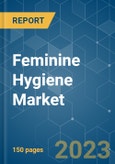Over the medium term, increasing awareness about personal hygiene and emerging low-cost products are expected to boost demand for the feminine hygiene products market. Moreover, the need for products such as tampons, menstrual cups, and internal cleansers and sprays is expected to increase in more developed regions, such as North America and Western Europe. The demand for biodegradable and organic raw materials-based female hygiene products is expected to generate opportunities for market players over the long term. Products like sanitary pads contain synthetic and carcinogenic materials like rayon, dioxin, metal dyes, and highly processed wood pulp, which often cause irritation and allergy in the genital organs of women. Owing to this, the demand for organic raw material-based sanitary napkin products is increasing.
The non-biodegradability of feminine hygiene products is currently a major environmental problem. However, to cater to the concern, reusable and alternative green products are being promoted to reduce the burden of waste generation due to single-time use pads & tampons and disposable deodorizing wipes. According to the article ‘Making Menstrual Products Eco-friendly,' published by Plastic Oceans International in February 2021, worldwide, nearly 45 billion menstrual products are used every year, and on average, 4,125 plastic bags are operated by a pad user over a lifetime. Therefore, reusable menstrual cups and reusable period underwear and pads are a few solutions gaining traction in the feminine hygiene products segment for minimizing waste generation.
Feminine Hygiene Products Market Trends
Increasing Government Initiatives Toward Menstrual Hygiene
The increasing awareness among consumers regarding menstrual hygiene and rising income levels are major factors stimulating the growth of feminine hygiene products, such as tampons, sanitary pads, and menstrual cups, globally. Moreover, governments of numerous countries are undertaking initiatives to distribute free sanitary pads. For instance, in March 2021, the Japanese government budgeted JPY 1.3 billion to help women needing menstrual products. The government also helped local municipalities by distributing sanitary pads and tampons to the public free of charge. The government is also taking initiatives to increase awareness of menopausal health and symptoms among women. Similarly, the Government of India partnered with several private entities and non-governmental organizations to take initiatives to popularize the use of sanitary napkins, particularly among underprivileged and rural women. These initiatives include the Reproductive and Child Health Program, Eco Femme, and My Pad. This generated awareness among women and increased the demand for budget-friendly sanitary pads, making them an essential commodity.Asia-Pacific is the Largest Market
Various companies have introduced different brands of feminine hygiene products for various economic sections of society. China’s local sanitary pads market has emerged as the largest market in the Asia-Pacific region. Though the awareness about hygiene products is less in the Asian markets, there is potential to be tapped into or explored by various companies. Owing to the increased demand for feminine hygiene products, manufacturers in Asia-Pacific are launching multiple products. Owing to several governments and NGO-led awareness programs across the region about women's menstrual hygiene, the demand for these products is growing in the Asia-Pacific region. For instance, in May 2021, UNICEF India launched a campaign called Red Dot Challenge. Through this campaign, UNICEF joined with adolescent girls, women, influencers, and celebrities and promoted safety and hygiene in all aspects of life, including menstrual hygiene and sanitation practices.Feminine Hygiene Products Industry Overview
The feminine hygiene market is highly competitive, with the presence of various global and regional companies. Some major companies in the market include Procter and Gamble, Unicharm Corporation, Kimberly-Clark Corporation, Johnson & Johnson, and Essity AB. Studies indicate that feminine hygiene products have some of the lowest penetration rates, with their affordability being a significant barrier. Considering these factors, various local players are providing low-cost sanitary napkins to promote feminine hygiene. Companies are engaging in frequent launches of newly developed products in developing and potential markets to improve their market position and revenue. Additionally, key players operating in the market are considering various factors to make their products more appealing to customers. For instance, Johnson & Johnson offers its Stayfree Dry Max Cover with Odor Control Technology, incorporating natural plant extracts to ensure a prolonged fresh feel.Additional Benefits:
- The market estimate (ME) sheet in Excel format
- 3 months of analyst support
This product will be delivered within 2 business days.
Table of Contents
Companies Mentioned (Partial List)
A selection of companies mentioned in this report includes, but is not limited to:
- Procter & Gamble Company
- Kimberly-Clark Corporation
- Unicharm Corporation
- Johnson & Johnson Services, Inc.
- Essity AB
- Ontex Group NV
- Edgewell Personal Care Company
- Unilever PLC
- TZMO SA
- Kao Corporation








